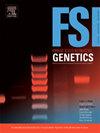Human identification of single hair shaft using a mass spectrometry mRNA typing system
IF 3.2
2区 医学
Q2 GENETICS & HEREDITY
引用次数: 0
Abstract
Hair is one of the most common forms of forensic biological material at various crime scenes. So far, human identification cannot be effectively accomplished with a single telogen hair encountered in forensic casework due to the detection limit. Emerging studies have revealed RNA as a promising biomarker in hair shafts, while the single telogen hair could not be successfully genotyped even after being examined with the recently developed mRNA typing system. MALDI-TOF MS, the matrix-assisted laser desorption/ionization time-of-flight mass spectrometry, enables sensitive and accurate measurement of DNA products. To address this problem and further develop the analysis technology of hairs, we established a mass spectrometry system for human identification based on a single hair shaft using 25 polymorphic SNPs located on 18 mRNA molecules (KRT31, RFK, KRT86, KRT35, PABPC1, KMT2D, LEMD2, TBC1D4, CTC1, PPP1R15A, RBM33, LRRC15, KRT33A, KRTAP12–2, KRT81, AHNAK, KRTAP4–8, FLG2). The forensic application of the detection system was evaluated, and all hair samples used were collected from individuals in Shanxi province. Firstly, we demonstrated that the RNA typing results of a single hair shaft were in perfect concordance with DNA typing results and confirmed the consistency between hairs from different body parts. To assess the potential influence of positions along the hair shaft, 6 cm long hair shafts from the distal end were examined by the MALDI-TOF MS system, whose genotype could be successfully detected. The system was capable of detecting aged samples stored for 390 days and could also be employed on various types of hair samples, such as white hair and permed or dyed hair. Finally, 50 unrelated individuals from Shanxi province were genotyped for the population study, and the CDP of the system in the Shanxi population is 0.998928. In this study, we established a mass spectrometry system for human identification based on a single hair shaft. We used a single hair shaft, rather than multiple hair shafts reported in our previous report, to get a full typing profile. The system sensitivity was substantially enhanced, which provided a valuable strategy for forensic practice to perform human identification using hairs.
利用质谱 mRNA 分型系统识别人类的单根发丝
头发是各种犯罪现场最常见的法医生物材料之一。迄今为止,由于检测极限的原因,在法医案件工作中遇到的单根毛发无法有效地完成人体识别。新近的研究发现,RNA 是毛发中一种很有前途的生物标记物,但即使使用最近开发的 mRNA 分型系统对单根毛发进行检测,也无法成功地对其进行基因分型。MALDI-TOF MS(基质辅助激光解吸电离飞行时间质谱)可以灵敏准确地测量 DNA 产物。为了解决这一问题并进一步开发毛发分析技术,我们建立了一个基于单根毛发的质谱系统,利用位于 18 个 mRNA 分子上的 25 个多态 SNPs(KRT31、rfk、krt86、krt35、pabpc1、kmt2d、lemd2、tbc1d4、ctc1、ppp1r15a、rbm33、yrc15、krt33a、krtap12-2、krt81、ahnak、krtap4-8、flg2)上的 25 个多态 SNPs,建立了基于单根毛发的人体识别质谱系统。我们对该检测系统的法医应用进行了评估,使用的所有毛发样本均采集自山西省的个人。首先,我们证明了单根毛发的 RNA 分型结果与 DNA 分型结果完全一致,并证实了不同身体部位毛发之间的一致性。为了评估发干位置的潜在影响,我们用 MALDI-TOF MS 系统检测了从远端开始的 6 厘米长的发干,并成功地检测出了其基因型。该系统能够检测保存 390 天的老化样本,也可用于检测各种类型的头发样本,如白发、烫发或染发。最后,我们对来自山西省的 50 个无血缘关系的个体进行了基因分型,该系统在山西人群中的 CDP 为 0.998928。在这项研究中,我们建立了一个基于单根发丝的人体识别质谱系统。我们使用单根发轴,而不是之前报告中的多根发轴,以获得完整的分型特征。该系统的灵敏度大大提高,为法医实践提供了利用毛发进行人体识别的宝贵策略。
本文章由计算机程序翻译,如有差异,请以英文原文为准。
求助全文
约1分钟内获得全文
求助全文
来源期刊
CiteScore
7.50
自引率
32.30%
发文量
132
审稿时长
11.3 weeks
期刊介绍:
Forensic Science International: Genetics is the premier journal in the field of Forensic Genetics. This branch of Forensic Science can be defined as the application of genetics to human and non-human material (in the sense of a science with the purpose of studying inherited characteristics for the analysis of inter- and intra-specific variations in populations) for the resolution of legal conflicts.
The scope of the journal includes:
Forensic applications of human polymorphism.
Testing of paternity and other family relationships, immigration cases, typing of biological stains and tissues from criminal casework, identification of human remains by DNA testing methodologies.
Description of human polymorphisms of forensic interest, with special interest in DNA polymorphisms.
Autosomal DNA polymorphisms, mini- and microsatellites (or short tandem repeats, STRs), single nucleotide polymorphisms (SNPs), X and Y chromosome polymorphisms, mtDNA polymorphisms, and any other type of DNA variation with potential forensic applications.
Non-human DNA polymorphisms for crime scene investigation.
Population genetics of human polymorphisms of forensic interest.
Population data, especially from DNA polymorphisms of interest for the solution of forensic problems.
DNA typing methodologies and strategies.
Biostatistical methods in forensic genetics.
Evaluation of DNA evidence in forensic problems (such as paternity or immigration cases, criminal casework, identification), classical and new statistical approaches.
Standards in forensic genetics.
Recommendations of regulatory bodies concerning methods, markers, interpretation or strategies or proposals for procedural or technical standards.
Quality control.
Quality control and quality assurance strategies, proficiency testing for DNA typing methodologies.
Criminal DNA databases.
Technical, legal and statistical issues.
General ethical and legal issues related to forensic genetics.

 求助内容:
求助内容: 应助结果提醒方式:
应助结果提醒方式:


